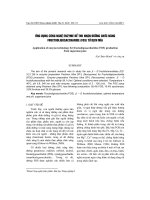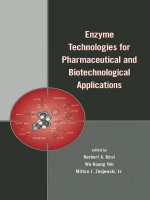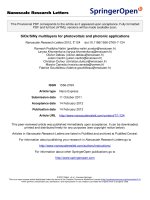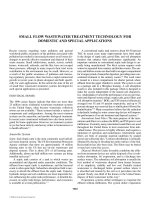enzyme technologies for pharm and biotech app
Bạn đang xem bản rút gọn của tài liệu. Xem và tải ngay bản đầy đủ của tài liệu tại đây (5.2 MB, 628 trang )
ISBN: 0-8247-0549-1
This book is printed on acid-free paper.
Headquarters
Marcel Dekker, Inc.
270 Madison Avenue, New York, NY 10016
tel: 212-696-9000; fax: 212-685-4540
Eastern Hemisphere Distribution
Marcel Dekker AG
Hutgasse 4, Postfach 812, CH-4001 Basel, Switzerland
tel: 41-61-261-8482; fax: 41-61-261-8896
World Wide Web
The publisher offers discounts on this book when ordered in bulk quantities. For more
information, write to Special Sales/Professional Marketing at the headquarters address
above.
Copyright 2001 by Marcel Dekker, Inc. All Rights Reserved.
Neither this book nor any part may be reproduced or transmitted in any form or by any
means, electronic or mechanical, including photocopying, microfilming, and recording,
or by any information storage and retrieval system, without permission in writing from
the publisher.
Current printing (last digit):
10987654321
PRINTED IN THE UNITED STATES OF AMERICA
Preface
Genes related to human and animal health are being discovered at an ever-increas-
ing rate. As gene products, enzymes are being explored for their function and
application in a rapidly emerging field that has been termed functional genomics.
Enzyme Technologies for Pharmaceutical and Biotechnological Applications fills
a unique niche for a comprehensive account of certain important enzymes in
human and animal health. Readers can also gain important insights into enzyme
technologies in both the pharmaceutical and biotechnological industries. The pri-
mary aim of this book is to highlight how, what, and where enzymes have become
critically important or are rapidly emerging in these two overlapping and interde-
pendent industries.
As a state-of-the-art work on enzyme technologies, the book covers four
basic principles and applications in (1) antibiotic biosynthesis, (2) biocatalysis,
(3) modern screening/optimization, and (4) emerging new technologies. In Part
I, on biosynthesis, the emphasis is placed on both improvements in antibiotic
yield and ways to increase antibiotic structural diversity by modifications of the
biosynthetic pathways from diverse microorganisms. Here, the emphasis is on
using genes to deliver enzymes and to thereby perform metabolic engineering
including precursor-directed biosynthesis or mutasynthesis. The use of recombi-
nant techniques to generate protein products that are unnatural to the microbial
world is also discussed, using specific examples of challenging problems in this
area.
Part II on biocatalysis, covers the direct application of enzymes as chemical
tools in manipulating small- to medium-sized synthetic organic compounds. Ma-
nipulation of the enzyme tools by genetic engineering is described. Chapter 8
iii
iv Preface
discusses how a novel form of enzymes, cross-linked enzyme crystals (CLCs), are
especially useful as chemical catalysts. An example of a large-scale application of
these chemical tools brings the area into focus by leaving the laboratory and
entering the manufacturing plant.
Part III on screening for and optimization of enzyme inhibitors describes
integrated approaches in therapeutic discovery research using enzyme targets rel-
evant to human and animal diseases. For high-throughput screening, the activity
assays for the enzyme targets adopt both conventional (colorimetry, spectrometry,
and radioactivity) and contemporary methodologies (fluorescence). A selective
enzymatic assay maximizes validated hits from large diversified libraries of sam-
ples derived from natural products and synthetic compounds, including those
arising from combinatorial chemistry. The chapters on screening concentrate on
development of effective enzymatic assays, each of which represents specific,
kinetic, and molecular interactions between the enzyme and its substrate as well
as inhibitors and thus reflects the pharmacological and chemical interplay at the
targeted enzyme. The primary screening goal is the production of manageable
numbers of hits that ultimately generate high-quality lead compounds. As a prac-
tical rule, optimization of those lead compounds by medicinal chemists is the
critical follow-up step required for the discovery of viable drug candidates. The
process of lead compound optimization for an enzyme inhibitor, often referred
to as structure-activity relationship studies or drug design, is dictated by under-
standing the molecular and kinetic interactions between the enzyme and its inhibi-
tor. These insights are typically gained by analyzing X-ray crystallographic depic-
tions and by elucidating the kinetic behavior of the enzyme-inhibitor complex
to improve potency and selectivity and to understand mechanisms of interactions.
The chapters on inhibitor screening/optimization emphasize the synergistic im-
portance of high-throughput screening and structure-function based optimization
studies for therapeutic discovery programs.
Finally, Part IV on emerging technologies examines some non-traditional
methods by which enzymes may play important new roles in the drug discovery
processes of the future. The present ability to completely locate and sequence
the gene clusters responsible for the multistep biosyntheses of complex natural
products has spawned new technologies. Such technologies can precisely and/
or deliberately modify certain parts of gene clusters within organisms or, alterna-
tively, can interchange portions of gene clusters between organisms. In each in-
stance, new unnatural natural products may be formed by fermentation of the
new genetically modified microorganisms. The exchange of genetic material can
be logically extended into a combinatorial paradigm called combinatorial biosyn-
thesis or combinatorial enzymology, thereby leading to even larger numbers of
new natural products. Extensive interdisciplinary collaboration between new tar-
get identification and screening laboratories, medicinal chemists, and molecular
modeling/computational chemists will become even more essential in the future
for rapid discovery of useful new entities to evaluate in the field or clinic.
Preface v
The last chapters of Part IV describe essential and overlapping enzyme
technologies. With the completion of most of the human genome sequence, as-
signing a precise function to genes ( functional prediction) and redesigning the
function of enzymes (enzyme engineering) can play increasingly significant roles
in drug discovery. Also, the utility of functional genomics in identifying disease-
relevant enzyme targets depends closely on the molecular understanding of these
targets under physiological and pathological conditions ( functional proteomics).
Enzyme Technologies for Pharmaceutical and Biotechnological Applica-
tions is informative, practical, timely, and applicable worldwide to the pharma-
ceutical and biotechnological industries. Real-world examples provided through-
out the book are important for discriminating between the use of enzymes solely
for academic studies and the practical use of enzymes in industrial applications.
The reader will acquire a better understanding of applied sciences in the field.
Areas that have been extensively covered in reviews and the general literature
(such as use of natural lipases in organic synthesis) have been minimized here.
By focusing on real-world applications, the reader will obtain a clearer under-
standing of what is new and relevant in the field.
The book is intended primarily for industrial and research scientists with
interests in adopting and maximizing enzyme technologies for pharmaceutical
discovery, development, and manufacturing. The book can also be used by gradu-
ate and postdoctoral students in practical enzymology, biochemistry, microbiol-
ogy, molecular biology, and biochemical engineering, as well as by students in
graduate-level courses covering practical enzymology and enzyme biochemistry.
Herbert A. Kirst
Wu-Kuang Yeh
Milton J. Zmijewski, Jr.
Contents
Preface iii
Contributors xi
I. Biosynthesis
1. δ-(L-α-Aminoadipyl)-L-Cysteinyl-D-Valine Synthetase as a
Model Tripeptide Synthetase 1
Hans von Do
¨
hren, Wibke Kallow, Mary Anne Tavanlar, Torsten
Schwecke, Ralf Dieckmann, and Volker Uhlmann
2. Metabolic Engineering for Cephalosporin C Yield Improvement
and Production of Intermediates 39
Joe E. Dotzlaf, Steven W. Queener, and Wu-Kuang Yeh
3. Bioconversion of Penicillins to Cephalosporins 61
Arnold L. Demain, Jose L. Adrio, and Jacqueline M. Piret
4. Direct Fermentative Production of Acyltylosins by Genetically
Engineered Strains of Streptomyces fradiae 89
Akira Arisawa and Hiroshi Tsunekawa
vii
viii Contents
5. Engineering Streptomyces avermitilis for the Production of
Novel Avermectins: Mutant Design and Titer Improvement 113
Claudio D. Denoya, Kim J. Stutzman-Engwall, and Hamish
A. I. McArthur
II. Biocatalysis
6. Biocatalytic Syntheses of Chiral Intermediates for
Antihypertensive Drugs 137
Ramesh N. Patel
7. Cloning, Structure, and Activity of Ketone Reductases from
Baker’s Yeast 175
Jon D. Stewart, Sonia Rodrı
´
guez, and Margaret M. Kayser
8. Cross-Linked Enzyme Crystals: Biocatalysts for the Organic
Chemist 209
Michael D. Grim
9. Enzymatic Deacylation of Echinocandins and Related
Antifungal Agents 227
Andrew R. Cockshott, Adam J. Kreuzman, and Wu-Kuang Yeh
III. Screening/Optimization
10. Roles of Enzymes in Antibacterial Drug Discovery 245
Siddhartha Roychoudhury
11. Penicillin-Binding Proteins as Antimicrobial Targets:
Expression, Purification, and Assay Technologies 263
Genshi Zhao, Timothy I. Meier, and Wu-Kuang Yeh
12. Development of a High-Throughput Screen for Streptococcus
pneumoniae UDP-N-Acetylmuramoyl-Alanine: d-Glutamate
Ligase (MurD) for the Identification of MurD Inhibitors 289
Michele C. Smith, James A. Cook, Gary M. Birch, Stephen A.
Hitchcock, Robert B. Peery, Joann Hoskins, Paul L. Skatrud,
Raymond C. Yao, and Karen L. Cox
13. Purification and Assay Development for Human Rhinovirus
Proteases 307
Q. May Wang and Robert B. Johnson
Contents ix
14. Screening for Parasiticides Using Recombinant Microorganisms 323
Timothy G. Geary
15. Screening for Inhibitors of Lipid Metabolism 343
Hiroshi Tomoda and Satoshi O
¯
mura
16. Design and Development of a Selective Assay System for the
Phospholipase A
2
Superfamily 379
Hsiu-Chiung Yang, Marian Mosior, and Edward A. Dennis
IV. Emerging Technologies
17. Understanding and Exploiting Bacterial Polyketide Synthases 397
Robert McDaniel and Chaitan Khosla
18. Polyketide Synthases: Analysis and Use in Synthesis 427
Kira J. Weissman and James Staunton
19. Enzymatic Synthesis of Fungal N-Methylated Cyclopeptides and
Depsipeptides 471
Mirko Glinski, Till Hornbogen, and Rainer Zocher
20. New Strategies for Target Identification, Validation, and Use of
Enzymes in High-Throughput Screening 499
Joaquim Trias and Zhengyu Yuan
21. Use of Genomics for Enzyme-Based Drug Discovery 515
Molly B. Schmid
22. Assigning Precise Function to Genes 537
Ridong Chen
23. Redesigning Binding and Catalytic Specificities of Enzymes 555
Ridong Chen
24. Proteomics: Chromatographic Fractionation Prior to Two-
Dimensional Polyacrylamide Gel Electrophoresis for Enrichment
of Low-Abundance Proteins to Facilitate Identification by Mass
Spectrometric Methods 575
Srinivasan Krishnan, John E. Hale, and Gerald W. Becker
Index 597
Contributors
Jose L. Adrio Department of Biochemistry, Antibioticos, S.A.U., Leo
´
n, Spain
Akira Arisawa Biochemistry Laboratory, Central Research Laboratories, Mer-
cian Corporation, Fujisawa, Japan
Gerald W. Becker Lilly Research Laboratories, Eli Lilly and Company, India-
napolis, Indiana
Gary M. Birch Lilly Research Laboratories, Eli Lilly and Company, Indianap-
olis, Indiana
Ridong Chen Department of Biochemistry, University of Saskatchewan, Sas-
katoon, Saskatchewan, Canada
Andrew R. Cockshott Lilly Research Laboratories, Eli Lilly and Company,
Indianapolis, Indiana
James A. Cook Lilly Research Laboratories, Eli Lilly and Company, Indianap-
olis, Indiana
Karen L. Cox Lilly Research Laboratories, Eli Lilly and Company, Indianapo-
lis, Indiana
xi
xii Contributors
Arnold L. Demain Department of Biology, Massachusetts Institute of Tech-
nology, Cambridge, Massachusetts
Edward A. Dennis Department of Chemistry and Biochemistry, Revelle Col-
lege and School of Medicine, University of California, San Diego, California
Claudio D. Denoya Bioprocess Research, Global Research and Development,
Pfizer, Inc., Groton, Connecticut
Ralf Dieckmann Biotechnology Center, Technical University Berlin, Berlin,
Germany
Joe E. Dotzlaf Lilly Research Laboratories, Eli Lilly and Company, Indianapo-
lis, Indiana
Timothy G. Geary Discovery Research, Pharmacia Animal Health, Kalama-
zoo, Michigan
Mirko Glinski Max Volmer Institute for Biophysical Chemistry and Biochem-
istry, Technical University Berlin, Berlin, Germany
Michael D. Grim Westboro, Massachusetts
John E. Hale Lilly Research Laboratories, Eli Lilly and Company, Indianapo-
lis, Indiana
Stephen A. Hitchcock Lilly Research Laboratories, Eli Lilly and Company,
Indianapolis, Indiana
Till Hornbogen Max Volmer Institute for Biophysical Chemistry and Bio-
chemistry, Technical University Berlin, Berlin, Germany
Joann Hoskins Lilly Research Laboratories, Eli Lilly and Company, Indianap-
olis, Indiana
Robert B. Johnson Lilly Research Laboratories, Eli Lilly and Company, India-
napolis, Indiana
Wibke Kallow AnagnosTec GmbH, Luckenwalde, Germany
Margaret M. Kayser Department of Chemistry, University of New Bruns-
wick, Saint John, New Brunswick, Canada
Contributors xiii
Chaitan Khosla Departments of Chemistry and Chemical Engineering, Stan-
ford University, Stanford, California
Adam J. Kreuzman Lilly Research Laboratories, Eli Lilly and Company, Indi-
anapolis, Indiana
Srinivasan Krishnan Lilly Research Laboratories, Eli Lilly and Company, In-
dianapolis, Indiana
Hamish A. I. McArthur Bioprocess Research, Global Research and Develop-
ment, Pfizer, Inc., Groton, Connecticut
Robert McDaniel Kosan Biosciences, Inc., Hayward, California
Timothy I. Meier Lilly Research Laboratories, Eli Lilly and Company, India-
napolis, Indiana
Marian Mosior Lilly Research Laboratories, Eli Lilly and Company, Indianap-
olis, Indiana
Satoshi O
¯
mura Research Center for Biological Function, The Kitasato Insti-
tute and Graduate School of Pharmaceutical Sciences, The Kitasato Institute and
Kitasato University, Tokyo, Japan
Ramesh N. Patel Process Research and Development, Bristol-Myers Squibb
Company, New Brunswick, New Jersey
Robert B. Peery Lilly Research Laboratories, Eli Lilly and Company, India-
napolis, Indiana
Jacqueline M. Piret Biology Department, Northeastern University, Boston,
Massachusetts
Steven W. Queener Lilly Research Laboratories, Eli Lilly and Company, Indi-
anapolis, Indiana
Sonia Rodrı
´
guez Department of Chemistry, University of Florida, Gainesville,
Florida
Siddhartha Roychoudhury Discovery-Biology, Procter & Gamble Pharma-
ceuticals, Mason, Ohio
xiv Contributors
Molly B. Schmid Microcide Pharmaceuticals, Inc., Mountain View, California
Torsten Schwecke Biotechnology Center, Technical University Berlin, Berlin,
Germany
Paul L. Skatrud Lilly Research Laboratories, Eli Lilly and Company, India-
napolis, Indiana
Michele C. Smith Lilly Research Laboratories, Eli Lilly and Company, India-
napolis, Indiana
James Staunton Department of Chemistry, University of Cambridge, Cam-
bridge, United Kingdom
Jon D. Stewart Department of Chemistry, University of Florida, Gainesville,
Florida
Kim J. Stutzman-Engwall Bioprocess Research, Global Research and Devel-
opment, Pfizer, Inc., Groton, Connecticut
Mary Anne Tavanlar National Institute of Molecular Biology and Biotechnol-
ogy, University of the Philippines Los Ban
˜
os, Laguna, Philippines
Hiroshi Tomoda Research Center for Biological Function, The Kitasato Insti-
tute and Graduate School of Pharmaceutical Sciences, The Kitasato Institute and
Kitasato University, Tokyo, Japan
Joaquim Trias Department of Microbiology, Versicor, Inc., Fremont, Cali-
fornia
Hiroshi Tsunekawa Pharmaceuticals and Chemicals Division, Mercian Corpo-
ration, Tokyo, Japan
Volker Uhlmann Department of Histopathology, St. James’s Hospital, Dublin,
Ireland
Hans von Do
¨
hren Biotechnology Center, Technical University Berlin, Berlin,
Germany
Q. May Wang Lilly Research Laboratories, Eli Lilly and Company, Indianapo-
lis, Indiana
Contributors xv
Kira J. Weissman Department of Biochemistry, University of Cambridge,
Cambridge, United Kingdom
Hsiu-Chiung Yang Lilly Research Laboratories, Eli Lilly and Company, Indi-
anapolis, Indiana
Raymond C. Yao Lilly Research Laboratories, Eli Lilly and Company, India-
napolis, Indiana
Wu-Kuang Yeh Lilly Research Laboratories, Eli Lilly and Company, India-
napolis, Indiana
Zhengyu Yuan Versicor, Inc., Fremont, California
Genshi Zhao Lilly Research Laboratories, Eli Lilly and Company, Indianapo-
lis, Indiana
Rainer Zocher Max Volmer Institute for Biophysical Chemistry and Biochem-
istry, Technical University Berlin, Berlin, Germany
1
δ-(L-α-Aminoadipyl)-L-Cysteinyl-D-
Valine Synthetase as a Model
Tripeptide Synthetase
Hans von Do
¨
hren, Torsten Schwecke, and Ralf Dieckmann
Technical University Berlin, Berlin, Germany
Wibke Kallow
AnagnosTec GmbH, Luckenwalde, Germany
Mary Anne Tavanlar
University of the Philippines Los Ban
˜
os, Laguna, Philippines
Volker Uhlmann
St. James’s Hospital, Dublin, Ireland
I. INTRODUCTION
A. Nonribosomal Peptide-Forming Systems and Penicillin
As beta-lactam antibiotics continue to be a major contributor to human health
preservation, research on the biosynthesis of penicillin, an almost ancient drug,
continues to open up roads to new technologies and perspectives. The provision
of precursor peptides to be transformed enzymatically with chemically un-
achieved efficiency into mono- or bicyclic antibiotics has been termed by Jack
Baldwin and colleagues ‘‘the irreversible commitment of metabolic carbon to
the secondary metabolism’’ [1]. The synthesis of such peptides is indeed per-
formed by a remarkable class of synthetases which, in contrast to the protein-
synthesizing machinery, have been termed a nonribosomal system or nonribo-
somal peptide synthetases (NRPS) [2]. These peptide synthetases have been
shown to catalyze the irreversible synthesis of peptides differing both in sequence
and structural variability, thus extending the scope of directly gene-encoded poly-
1
2 von Do
¨
hren et al.
peptides. The synthetic principle, unravelled mainly by Kiyoshi Kurahashi, So
¨
ren
Laland, Fritz Lipmann, and later Horst Kleinkauf and colleagues (reviewed in
[3]), consists of a process of amino acid selection, activation of carboxyl groups
as adenylates, formation of stable thioester intermediates, and successive conden-
sations in an assembly-line process with no free intermediates. The enzymatic
machinery thus resembles a kind of self-feeding solid-phase process. Similar se-
quential condensation processes are known from polyketides and related acetate-
derived compounds, and many compounds combining the respective building
blocks in mixed biosynthetic systems are known.
A major step in our continuing understanding of these remarkable multistep
systems goes back to the cloning of the peptide synthetase producing the penicil-
lin precursor tripeptide δ-(L-α-aminoadipyl)-L-cysteinyl-D-valine (ACV). The
first sequences of this remarkable and quite large gene became available in 1990,
derived from Penicillium chrysogenum [4,5], Aspergillus nidulans [6], Acremo-
nium chrysogenum [7], and Nocardia lactamdurans [8]. These efforts immedi-
ately led to the revision of the classical thiotemplate model to the multiple-carrier
thiotemplate model [9,10], which was later verified experimentally [11,12]. At
the same time, the ACV synthetase sequences were the first to introduce us to
the multidomain structure of this class of enzymes, and thus initiated the still-
continuing efforts to understand the molecular principles of multistep synthetases
and synthases.
B. From Tripeptide to Synthetase
The formation of the tripeptide ACV (the Arnstein tripeptide) upon feeding of
labeled valine to mycelia of P. chrysogenum had already been shown by Arnstein
and co-workers in 1960 [13,14], and demonstrated later in cell-free extracts by
Bauer [15]. In more refined work, Abraham and Loder established in extracts
of A. chrysogenum the MgATP
2Ϫ
-dependent formation of ACV from δ-(L-α-
aminoadipyl)-L-cysteine (AC) and L-valine [16,17], while no product was ob-
served with L-α-aminoadipate (Aad) and L-cysteinyl-L-valine (LL-CV), or AC
and D-valine. The stereochemistry of the tripeptide has been established as LLD
[18,19], and the biosynthesis from the respective L-configured amino acids was
again demonstrated in a beta-lactam-defective mutant by Shirafuji and colleagues
[20]. This mutant Takeda N2 of A. chrysogenum, later shown to carry a point
mutation in the isopenicillin N synthase gene, was shown by Adlington and co-
workers to produce both AC and ACV [21]. Among tripeptide analogs isolated
from fermentation broth were Aad-Ala-D-Val (D configuration not proven), Aad-
Ser-D-Val, and Aad-Ser-isodehydro-Val [22]. At that time it was generally ac-
cepted that the Arnstein tripeptide would be the product of two consecutive reac-
tions catalyzed by the hypothetical AC and ACV synthetases [23]. Thus Lara and
colleagues, studying the stimulation of penicillin formation in P. chrysogenum by
L-glutamate, determined the hypothetical level of AC synthetase by phosphate
␦-(L-␣-Aminoadipyl)-L-Cysteinyl-D-Valine Synthetase 3
consumption from MgATP
2Ϫ
in the presence of Aad and Cys, without product
analysis [24].
The possible analogy of ACV formation to the well-established thiotem-
plate processes had earlier led Feodor Lynen (H. Bergmeyer, unpublished data)
and then Arny Demain to take a closer look at these synthetases. Employing the
industrial strain C-10 of A. chrysogenum (ATCC 48272), Banko in Demain’s
laboratory succeeded in isolating an AC-forming enzyme [25], and later showed
the rate of ACV production by this preparation from the three amino acids to be
faster than from AC and L-valine [26]. Similar results were obtained by Jensen
in Westlake’s laboratory with the actinomycete Streptomyces clavuligerus [27],
and ACV synthesis was also achieved with an immobilized enzyme preparation
bound to an anion-exchange resin [28]. The isolation and purification of an ACV
synthetase has first been reported with the A. nidulans enzyme [29], later to be
followed by synthetases from A. chrysogenum [30–32] and S. clavuligerus [33–
36]. These studies established a single multienzyme to be responsible for the
synthesis of ACV from Aad, Cys, Val, and MgATP
2Ϫ
. An associated protein
in the S. clavuligerus preparation [34] was later shown to be proclavaminate
amidinohydrolase [37]. Thus, possible in vivo interactions with other proteins in
this biosynthetic process are lost during standard purification operations.
II. ACV SYNTHETASES: ORGANIZATION, PURIFICATION,
AND CHARACTERIZATION
A. Overall Organization
Protein sequence data of prokaryotic and eukaryotic ACV synthetases reveal a
similar organization of three adenylate domains, three thiolation domains (carrier
proteins), two condensation domains, one epimerization domain, and one thioes-
terase domain. These domains have been well characterized from multiple se-
quence data of various NRPS systems [38–40] and data are easily accessable,
with the terms AMP binding domain for adenylate domains (IPR000873,
PS00012, PF00501); pp-binding, phosphopantetheine,oracp domain for thiola-
tion domains (IPR000255, PS00455, PF00550); condensation and epimerization
domains as DUF4 (IPR001240) with unknown function; and thioesterase do-
mains (IPR001031). A primary approach in the identification of domains is the
detection of highly conserved core sequences. Such sequences have been derived
from selected NRPS data [38]. The respective ACV synthetase cores show an
excellent agreement with little deviation (Table 1). Inspection of the primary
data shows alterations especially in the C-terminal subdomains of the adenylate
domains (motifs A8–A10), and in the condensation domains. Domain boundaries
can be predicted from multiple alignments, which help to identify linker regions
[41]. The unique availability of both prokaryotic and eukaryotic sequences may
provide additional insights not yet evaluated by data analysis. These sequences
4 von Do
¨
hren et al.
include the far N-terminal regions of about 40 amino acid residues present in
fungal synthetases, which points also to some insecurity with respect to initiation
sites and the actual terminal sequences. Another interesting region is the N-
terminal region of about 200 amino acids preceding the first adenylation domain,
which shows significant similarities to an internal region of condensation do-
mains. The recent identification of terminal and linker-associated sequences in-
volved in domain interactions has not yet been investigated in NRPS systems
[42,43].
As the second elementary step of data analysis, the comparative multiple
alignment of the identified domains is conducted. Complete adenylate domain
sequences provide an ACV synthetase cluster, with subclusters of the individual
adenylate domains in positions 1, 2, and 3 [44]. This clustering indicates a similar-
ity of ACV synthetase domains compared to other NRPS systems, and a likewise
similarity of the domains in their respective positions. This clustering has been
taken as evidence for the evolution of NRPS by gene duplication within individ-
ual systems [45], and would as well support the horizontal gene transfer hypothe-
sis of beta-lactam biosynthetic clusters [46]. A different picture, however,
emerges when the sequences of thiolation or condensation domains are compared:
the carrier domains of the first modules are found in a different cluster than those
of the second and third module [47]. Likewise, a CLUSTAL alignment of the
two condensation domains places them in different contexts, which have been
speculatively correlated with the specific type of condensation reaction (linking
a δ-carboxyl group with an α-amino group, or linking a cysteine carboxyl group
with an α-amino group) [47]. The condensation domain-related epimerization
domain is found within the respective cluster of epimerization domains. Thus, if
applied to thiolation, condensation, or epimerization domains, the system-specific
clustering observed for adenylation domains is not evident, possibly due to the
more diverse differences in functions. More detailed structural investigations are
needed to interpret the functional significance of these observations.
The three-module system found in all ACV synthetases correlates well with
the sequential condensation, epimerization, and hydrolytic release of the tripep-
tide. At first sight, the arrangement of domains and modules fits perfectly the
collinearity rule found in the majority of NRPS systems, which implies that the
linear sequence of domains corresponds to the sequence of reactions of the path-
way [40,45].
B. Purification Work and Protein Studies
Studies have been performed on the purification and characterization of synthe-
tases from A. nidulans, A. chrysogenum, S. clavuligerus, Flavobacterium sp. [48],
N. lactamdurans [49], and P. chrysogenum [50]. Except for Flavobacterium
and S. clavuligerus, the complete gene sequences are available, which reveal
␦-(L-␣-Aminoadipyl)-L-Cysteinyl-D-Valine Synthetase 5
Table 1
NRPS Core Sequences and Their Conservation in ACV Synthetases
Adenylate domains
a
A3
A1
A2
LAYxxTTSGSTGx PKG
LTYxEL
LKAGxAYLVPLD
T
SL
I
Module 1
b
P. chrysogenum
LTYGEL
WKSGAAY VPID
LAYVTYTSGTTGF PKG
A. chrysogenum
LTYGEL
WKSGAAY VPID
LAYVTYTSGTTGF PKG
A. nidulans
LTYGEL
WKSGAAY VPID
LAYVTYTSGTTGF PKG
Lysobacter
sp.
ITYEEL
WKSGAAH
VPID
LAYAIYTSGTTGRPVPKA
N. lactamdurans
LSYREL
WKAGAAY VPID
RAYVTYTSGTTGV PKG
Module 2
P. chrysogenum
LTYREL
WKSGGAY VPID
LAYIIYTSGTTGR PKG
A. chrysogenum
LTYREL
WKTGGAY VPID
LAYIIYTSGTTGK PKG
A. nidulans
LTYREL
WKSGGAY VPID
LAYIMYTSGTTGN PKG
Lysobacter
sp.
LSYREL
WKAGGAY VPID
LAYAIYTSGTTGR PKG
N. lactamdurans
LTYREL
WKTGGAY VPID
LAYIIYTSGTTGK PKG
Module 3
P. chrysogenum
LSYADL
WKAGAAY VPLD
LAYIIFTSGTSGK PKG
A. chrysogenum
LSYTEL
WKTGSAY VPLD
LAYIIFTSGTSGK PKG
A. nidulans
LSYSEL
WKAGAAY VPLD
LAYVIFTSGTSGK PKG
Lysobacter
sp.
LSYREL
WKAGAAY VPID
LAYAIYTSGTSGR PK
A
N. lactamdurans
TTYREL
WKAGAAY MPLD
LAYAIFTSGTSGK PKG
6 von Do
¨
hren et al.
Table 1
Continued
Adenylate domains
a
A4
A5
A6
FDxS
NxYGPTE
GELxIxGxGVARGYL
Module 1
L
P. chrysogenum
FEPV
NEYGFTE
GELHIGGLGISKGYL
A. chrysogenum
FEPV
NEYGFTE
GELHIGGLGISKGYL
A. nidulans
FEPV
NEYGFTE
GELHIGGLGISRGYL
Lysobacter
sp.
FDHF
NGYGPTE
GELYIGGLGVAKGYL
N. lactamdurans
FEPH
NEYAFTE
GELHIGGCGISPGYL
Module 2
P. chrysogenum
FDHF
NGYGPTE
GELYLGGEGVVRGYH
A. chrysogenum
FDHF
NGYGPTE
GELYLGGEGVARGYH
A. nidulans
FDHF
NGYGPTE
GELYLGGDGVARGYH
Lysobacter
sp.
FDHF
NGYGPTE
GELYIGGIGVARGYH
N. lactamdurans
FDHF
NGYGPTE
GELYIGGIGVTRGYH
Module 3
P. chrysogenum
FDFS
NAYGVTE
GELHIGGLGISKGYL
A. chrysogenum
FDFS
NAYGVTE
GELHIGGLGISKGYL
A. nidulans
FDFS
NAYGVTE
GELHIGGLGISRGYL
Lysobacter
sp.
FDFS
NAYGTTE
GELYIGGLGVAKGYL
N. lactamdurans
FDFS
NAYATTE
GELHIGGCGISPGYL
␦-(L-␣-Aminoadipyl)-L-Cysteinyl-D-Valine Synthetase 7
Adenylate domains
a
A7
A8
A9
YRTGDL
GRxDxQVKIRGxRIELGEIE
LPxYMIP
K
V
Module 1
P. chrysogenum
YKTGDL
GRADFQIKLRGIRIEPGEIE
LPRYMIP
A. chrysogenum
YKTGDL
GRADFQIKLRGIRIEPGEIE
LPRYMVP
A. nidulans
YKTGDL
GRADFQIKLRGIRIEPGEIE
LPRYMVP
Lysobacter
sp.
YKTGDL
GRNDMQVKIRGQRIELGEVE
LPQAIIP
N. lactamdurans
YRTGDL
GRADFQLKLNGVRIEPGEIE
LIRIMVP
Module 2
P. chrysogenum
YKTGDL
GRNDFQVKIRGLRIELGEIE
LPGYMVP
A. chrysogenum
YRTGDL
GRNDFQVKIRGLRIELGEIE
LPGYMIP
A. nidulans
YKTGDL
GRNDFQVKIRGQRIELGEIE
LPDYMVP
Lysobacter
sp.
YKTGDL
GRNDMQVKIRGLRVELGEIE
LPQAIVP
N. lactamdurans
YRTGDL
GRTDLQVKIRGLRIELGEIE
LPESVVP
Module 3
P. chrysogenum
YKTGDL
GRGDLQIKMRGYRIEISE
LPTYMVP
A. chrysogenum
YKTGDL
GRADLQVKMRGYRIEPSE
LPAYMVP
A. nidulans
YKTGDL
GRKDQQVKLRGFRIELSE
LPPYMVP
Lysobacter sp.
YKTGDL
GRNDHQVKINGVRIELGE
LTPAMMP
N. lactamdurans
YRTGDL
GRNDAQVKINGLRIEPGE
LMPSMVP
8 von Do
¨
hren et al.
Table 1
Continued
Adenylate
Condensation
domain
a
Thiolation domain
domain
A10
T
C1
NGKVDR
DxFFxxLGGHSI
SxAQxRLWxL
DL
MY
Domain 1
P. chrysogenum
NGKADL
DNFFR LGGHSI
ANSLQQGFV
A. chrysogenum
NGKADL
DNFFR LGGHSI
ANSLQQGFV
A. nidulans
NGKADL
SNFFR LGGHSI
ANSLQQGFV
Lysobacter
sp.
SGKLDV
DDIFG
SGGDSL
A QERLL
N. lactamdurans
NGKVDW
DDIFR LGGQSI
ANGLQQGFV
Domain 2
P. chrysogenum
SGKLDT
DFFFS LGGDSL
SRAQERLLFI
A. chrysogenum
SGKLDL
DFFFT LGGDSI
SPAQERLLFI
A. nidulans
SGKLDAS
FFFR LGGDSI
SPAQERLMFI
Lysobacter
sp.
SGKLDV
DFIFG
SGGDSL
SLAQERLLFI
N. lactamdurans
SGKLMA
DFFAR
AGGDSI
SLAQERLLFI
Domain 3
P. chrysogenum
NGKLDV
DDDLFKLGGDSI
A. chrysogenum
NGKLDV
DDDLFRLGGDSI
A. nidulans
NGKLDL
DDDLFARGGDSI
Lysobacter sp.
SGKLDVH
DDLFQIGGDSL
N. lactamdurans
TGKLDV
DDDLFRCGGDSI









